
Parks
Website Design and Content
© by Eric Krause, Krause
House Info-Research Solutions (©
1996)
All Images
© Parks Canada Unless Otherwise Designated
Researching the Fortress of Louisbourg National Historic Site of Canada
Recherche sur la Forteresse-de-Louisbourg Lieu historique national du
Canada
Parks
Canada ~ Parcs Canada
Cape Breton ~ Le
Cap-Breton

THIS RESEARCH AND GENEALOGICAL WEBSITE WAS ARCHIVED IN 2010
FORTRESS OF LOUISBOURG NATIONAL HISTORIC SITE OF CANADA (N.S.)
Ukumuljin El-kini'skwit Kloqoej
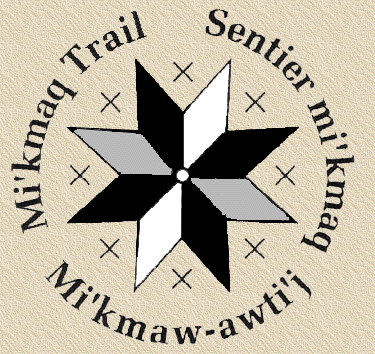
Kaqisi-milika'lut na wijey kloqoej. We'jiup kun'tew-wikasit ta'n ewikasikl kun'tal Kwepek, piamiw na'n kaskimtlnaqnipunqek tetuje'kl. Teli ankamkuk elawika'taqneyiktuk pikweli-e'wasin ta'pu kaskimtlnaqnipunqekek, aq kiskuk me'j wijey teli-e'ut.
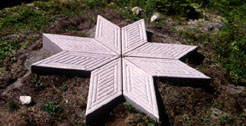 The eight-pointed
star is a symbol which has been used by the Mi'kmaq for centuries. It is a symbol for the
sun, which was a powerful figure in traditional spiritual life. Early missionaries
remarked on the great spirituality of the Mi'kmaq, as they would salute the Sun both at
its rising and its setting.
The eight-pointed
star is a symbol which has been used by the Mi'kmaq for centuries. It is a symbol for the
sun, which was a powerful figure in traditional spiritual life. Early missionaries
remarked on the great spirituality of the Mi'kmaq, as they would salute the Sun both at
its rising and its setting.
The eight-pointed star has countless variations. It has been found as a petroglyph tracing at a rock site in Bedford, dating back more than 500 years. It appears as a common design motif on 19th-century quillwork, and today continues to enjoy widespread popularity.
On Canada Day, 1995, the Fortress of Louisbourg National Historic Site and the Mi'kmaq First nation celebrated the official opening of a new trail at the Fortress.
Mi'kmaq Trail
The Mi'kmaq Trail is located close to the Visitor Centre of the Fortress of Louisbourg. It is open seven days a week from 9 AM to 7 PM.
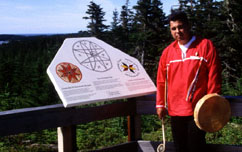
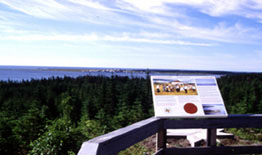
Three Mi'kmaq interpreters are on staff at the trail. They offer guided tours, discuss Mi'kmaq history and culture, explain traditional arts and crafts, and discuss the uses of medicinal plants.
In addition to the staff, the Mi'kmaq Trail features a reconstructed wigwam, exhibit panels and an 8-pointed star sculpted in granite. At the top of the trail is a commanding view of the Fortress and Louisbourg harbour.
Le sentier mi'kmaq se trouve prés du Centre d'accueil de la Forteresse de Louisbourg. Le sentier est ouvert tous les jours du 09h00 à 19h00.
Il y a trois interprètes autochtones sur le Sentier mi'kmaq. Ils offrent des visites guidées, en parlant de l'histoire et de la culture mi'kmaq, des arts et métiers traditionnels, et l'usage des herbes et des plantes.
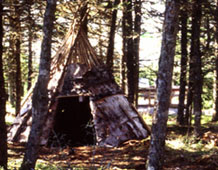 Également au Sentier
mi'kmaq, il y a un wigwam reconstitué, des expostions, et une sculpture en granit d'une
étoile à 8 branches. Au sommet il y a une vue panoramique de la Forteresse et du havre
de Louisbourg. Known as the "Mi'kmaq Trail", the trail is located close to the
Fortress Visitor Centre and leads to a look-off with a panoramic view of Louisbourg
harbour and the nearby coast.
Également au Sentier
mi'kmaq, il y a un wigwam reconstitué, des expostions, et une sculpture en granit d'une
étoile à 8 branches. Au sommet il y a une vue panoramique de la Forteresse et du havre
de Louisbourg. Known as the "Mi'kmaq Trail", the trail is located close to the
Fortress Visitor Centre and leads to a look-off with a panoramic view of Louisbourg
harbour and the nearby coast.
A highlight at the look-off is a carved granite 8-pointed star, a symbol of significance to the Mi'kmaq for untold centuries. The star was carved by Charles Doucette of the Chapel Island First Nation.
Along the trail are a number of interpretive panels-presented in both official languages as well as in Mi'kmaq. The panels present images and text on a range of topics, with both historical and contemporary information about the Mi'kmaq.
At the beginning of the trail, across from the Visitor Centre, stands a flag pole flying the Mi'kmaq flag.
All content on the trail-images and scripts-were developed jointly and cooperatively by Fortress staff and the Mi'kmaq consultants. Many ideas, including the 8-pointed star and the flag pole, came from Mi'kmaq consultants.
The July 1 opening of the trail marked the successful completion of a collaborative project begun some months earlier.
Staff at the Fortress of Louisbourg National Historic Site believed that if one was going to interpret Aboriginal history, the best way to do it was in partnership with Aboriginal people.
Accordingly, during 1994, the Fortress approached Dr. Peter Christmas, the Executive Director of the Micmac Association for Cultural Studies (MACS), to see if he would be interested in working with Park staff to develope a trail which would interpret different aspects of Mi'kmaq history and culture.
Dr. Christmas took a leading role in furthering the discussion and moving the project ahead from that point. Within a matter of weeks, the Chiefs of the reserve communities within Nova Scotia gave their support. Representatives from the reserve on Cape Breton Island were selected work with the Fortress staff to develop the project.
The representatives from the Mi'kmaq communities who worked with Parks staff were Norman Basque (Chapel Island), Allan Bernard (Waycobah), Darrell Bernard (Membertou), Dr. Peter Christmas (MACS), Sarah Denny (Eskasoni) and Deborah Ginnish (MACS). Pauline Lewis (then of Chapel Island) also contributed to the project early on.
Though not on the working committee, Chief Noel Doucette of Chapel Island made several helpful suggestions to move the project along.
Parks staff involved in the project were Sandy Balcom and John Johnston of the Fortress of Louisbourg, and Aynsley MacFarlane and Jack Stephens of the Bell Museum in Baddeck.